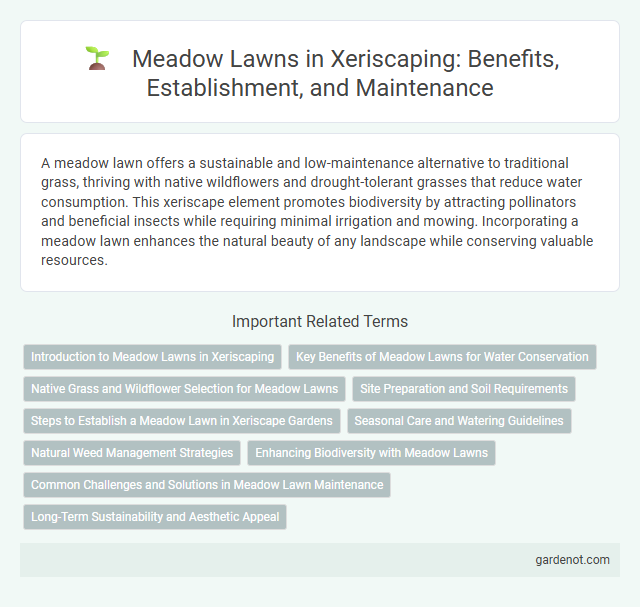A meadow lawn offers a sustainable and low-maintenance alternative to traditional grass, thriving with native wildflowers and drought-tolerant grasses that reduce water consumption. This xeriscape element promotes biodiversity by attracting pollinators and beneficial insects while requiring minimal irrigation and mowing. Incorporating a meadow lawn enhances the natural beauty of any landscape while conserving valuable resources.
Introduction to Meadow Lawns in Xeriscaping
Meadow lawns in xeriscaping offer a sustainable alternative to traditional turf, utilizing drought-resistant native grasses and wildflowers to reduce water consumption by up to 60%. These low-maintenance landscapes promote biodiversity, supporting pollinators and improving soil health with minimal irrigation. Integrating meadow lawns into xeriscaping enhances curb appeal while conserving water resources in arid and semi-arid regions.
Key Benefits of Meadow Lawns for Water Conservation
Meadow lawns significantly reduce water consumption by relying on native grasses and drought-tolerant plants that require minimal irrigation. Their deep root systems improve soil retention and promote groundwater recharge, effectively conserving water resources. By limiting the need for frequent watering, meadow lawns contribute to sustainable landscape practices in xeriscaping.
Native Grass and Wildflower Selection for Meadow Lawns
Selecting native grasses and wildflowers for meadow lawns promotes ecological balance by supporting local wildlife and reducing maintenance needs. Species such as Little Bluestem, Purple Coneflower, and Black-eyed Susan thrive in xeriscape conditions, offering drought tolerance and vibrant seasonal color. Incorporating a diverse mix enhances soil health, maximizes water efficiency, and creates a resilient, low-maintenance landscape.
Site Preparation and Soil Requirements
Meadow lawn establishment requires thorough site preparation, including removal of existing vegetation and debris to reduce competition and improve seed-to-soil contact. Soil should be well-drained with a slightly acidic to neutral pH (6.0-7.0), amended with organic matter to enhance moisture retention and nutrient availability. Proper soil texture, typically loamy or sandy loam, supports deep root development essential for drought-tolerant meadow grasses in xeriscape gardens.
Steps to Establish a Meadow Lawn in Xeriscape Gardens
Select native drought-tolerant grasses and wildflowers suited to your region to ensure low water usage and maximum resilience. Prepare the soil by removing existing turf, loosening the ground, and incorporating organic matter to promote root development. Sow seeds evenly, lightly rake the surface, and water consistently until germination, then reduce irrigation as the meadow establishes.
Seasonal Care and Watering Guidelines
Meadow lawns thrive with seasonal adjustments to mowing height, typically kept higher in spring and lowered in autumn to promote healthy root growth. Watering guidelines emphasize deep, infrequent irrigation, applying about 1 to 1.5 inches of water weekly during active growth periods to encourage drought resilience. Reducing irrigation in late fall and winter prevents root rot while maintaining soil moisture for early spring green-up.
Natural Weed Management Strategies
Meadow lawns utilize natural weed management strategies such as promoting dense, native plant growth to outcompete invasive species and minimize soil disturbance that encourages weed seed germination. Incorporating mulch and selective mowing schedules supports healthy plant diversity and suppresses weeds without chemical herbicides. These methods enhance soil health and biodiversity while reducing maintenance and environmental impact in xeriscaped landscapes.
Enhancing Biodiversity with Meadow Lawns
Meadow lawns significantly enhance biodiversity by providing a habitat rich in native wildflowers and grasses that support pollinators such as bees, butterflies, and beneficial insects. Unlike traditional turf, meadow lawns require fewer inputs like water and fertilizers, promoting a healthier ecosystem and reducing environmental impact. Their diverse plant structure fosters soil health, encourages wildlife, and contributes to a balanced urban or suburban landscape.
Common Challenges and Solutions in Meadow Lawn Maintenance
Meadow lawn maintenance often faces challenges such as invasive weed control, inconsistent mowing schedules, and nutrient management to support native grasses and wildflowers. Effective solutions include selective herbicide application tailored for broadleaf weeds, setting mowing heights to encourage biodiversity while preventing overgrowth, and using soil tests to guide organic fertilization that maintains soil health. Integrating drip irrigation systems can address drought stress, optimizing water use while preserving meadow ecosystem resilience.
Long-Term Sustainability and Aesthetic Appeal
Meadow lawns offer long-term sustainability by requiring significantly less water, fertilizer, and mowing compared to traditional grass lawns, reducing environmental impact and maintenance costs. These lawns promote biodiversity by supporting native plants and pollinators, enhancing the ecosystem's health and resilience. Their natural, diverse appearance provides aesthetic appeal through seasonal color variation and texture, creating an inviting and dynamic outdoor space.
Meadow lawn Infographic

 gardenot.com
gardenot.com